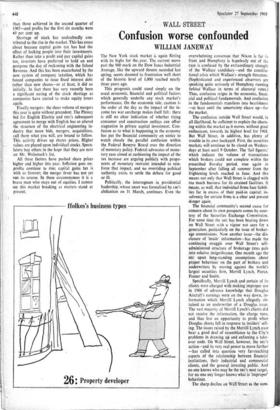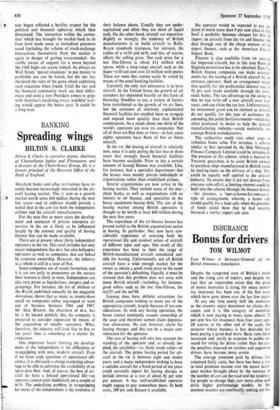Confusion worse confounded
WALL STREET WILLIAM JANEWAY
The New York stock market is again flirting with its highs for the.year. The current move past the 900 mark on the Dow Jones Industrial Average, like the upward thrusts recorded last spring, seems doomed to frustration well short of the historic level of 1,000 reached nearly three years ago.
This prognosis could stand simply on the usual economic, financial and political factors which generally underlie any stock market's performance. On the economic side, caution is the order of the day as the impact of the in- come tax war surcharge makes itself felt : there is still no clear indication of whether rising consumer and construction outlays can offset stagnation in priiate capital investment. Con- fusion as to what is happening in the economy has put the financial community on notice to watch closely the parallel confusion within the Federal Reserve Board over the direction of monetary policy. Federal advocates of mone- tary ease aimed at cushioning the impact of the tax increase are arguing publicly with propo- nents of monetary restraint intended to rein- force that impact, and no overriding political authority exists to settle the debate for good or ill.
Politically, the interregnum in presidential leadership, whose onset was formalised by Les abdication on 31 March, continues. Even the overwhelming consensus that Nixon is far in front and Humphrey is hopelessly out of the race is confused by the extraordinary strength of the Wallace candidacy—and the constitu- tional crisis which Wallace's strength threatens. (Sophisticated and experienced observers are speaking quite seriously of Humphrey running behind Wallace in terms of electoral votes.) Thus, confusion reigns in the economic, finan- cial and political fundamentals. And confusion in the fundamentals translates into bearishness —at least until the uncertainty clears up—for the market.
The confusion outside Wall Street would, in all likelihood, be sufficient to explain the churn- ing within the market as it moves, without great enthusiasm, towards its highest level for 1968. But Wall Street, in addition, has plenty of trouble in its own backyard. First, the securities markets will continue to be closed on Wednes- days at least until 9 October. The 'fail figures,' which indicate the volume of transactions which brokers could not complete within the prescribed five-day period, rose again in September after falling all summer from the frightening levels reached in June. And this means not only that Wall Street is clogged with too much business for its strained facilities. It means, as well, that individual firms face liabili- ties far in excess of their paid-in capital; in- solvency for certain firms is a clear and present danger again.
The financial community's second cause for concern about its own prospects comes by cour- tesy of the Securities Exchange Commission. For some time the SEC has been bearing down on Wall Street with a vigour not seen for a generation, particularly on the issue of broker- ige commissions. Now another issue—the dis- closure of 'inside' information-711as made the continuing struggle over Wall Street's self- administered structure of brokerage rates pale into relative insignificance. One month ago the sU.c upset long-standing assumptions about proper behaviour on the part of brokers and uiderwriters by moving against the world's largest securities firm, Merrill Lynch, Pierce, Fenner and Smith.
Specifically, Merrill Lynch and certain of its clients were charged with making improper use in 1966 of advance knowledge that Douglas Aircraft's earnings were on the way down, in- formation which Merrill Lynch allegedly ob- tained as an underwriter of a Douglas, issue. The vast majority of Merrill Lynch's clients did not receive the information, the charge runs, and thus lost an opportunity to profit when Douglas shares fell in response to insiders' sell- ing. The issues raised by the Merrill Lynch case bear a good deal of resemblance to the City's problems in drawing up and enforcing a take- over code. On Wall Street, hoWever, the SEC'S action—and its very real power to move further —has called into question very far-reaching aspects of the relationship between financial institutions, their industrial and commercial clients, and the general investing public. And no one knows who may be the SEC'S next target, for no one any longer knows what is 'improper' behaviour.
The sharp decline on Wall Street as the sum-
mer began reflected a healthy respect for the political and financial upheaval which then threatened. The 'correction within the correc- tion' which has brought the market-back to its June level made sense as immediate pressures eased (including the volume of stock-exchange transactions themselves). Now the market is again in danger of getting overextended: the visible means of support for a move beyond the 1968 highs are scanty indeed. As always on Wall Street, 'special situations' to put money to profitable use_can be found, but the sac has shattered the rules of the game about exploiting such situations when found. Until the sac and the financial community work out their differ- ences and until a new President comes to grips with America's escalating crises, watchful wait- ing would appear the better part. It could be a long wait.











































 Previous page
Previous page